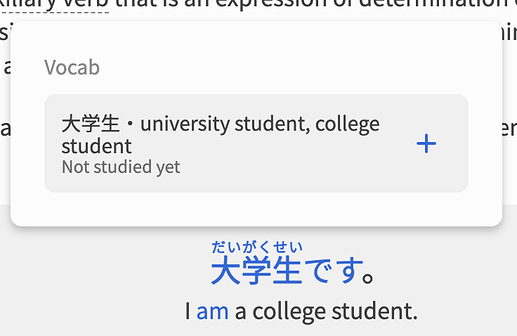Hey! Thanks for taking the time to share this. We definitely understand that learning grammar is tough on its own, and it can feel overwhelming when new vocabulary shows up at the same time.
Here’s a bit of background on why you’ll sometimes see “higher-level” words in N3 grammar sentences.
1. JLPT vocabulary lists aren’t official
The JLPT doesn’t publish word lists; all N1/N2/N3 tags are made by third parties, and they often disagree. For example, 「退職」 is labeled N1 in some lists, but you’ll see it used much earlier in real materials.
2. All serious resources mix levels
This isn’t unique to Bunpro. It also becomes much more frequent when you get to intermediate Japanese, where the lines between native content and learning materials begin to get more blurred. For example, Quartet 1 (a textbook used right after Genki, aimed around N3) also frequently uses “higher level” vocabulary:
Here is a quick excerpt from a Quartet 1 reading passage:
回転ずし入門
ネタの種類は豊富で、季節限定のネタや洋風の変わったネタもあるので、行くたびに楽しめるはずだ。またすし以外ににラーメンやデザートなどのサイドメニューを出す店も増えてきている。そして、回転ずしは通常、皿の色ごとに値段が決まっている。だから、メニューがなく値段がわからない高級なすし屋とは違って、回転ずしなら安心して好きなものを選ぶことができる。
入門・ネタ・限定・洋風・デザート・サイドメニュー・通常・高級・屋 are all considered N2 and higher.
3. Why we do this
We want sentences to feel natural and engaging, not like artificial baby-talk Japanese. That means you’ll sometimes get bonus exposure to words outside your “target” level, just like in real conversations, where you can’t ask a native speaker to only use N3 vocab. These extra encounters aren’t meant to be memorized on the spot; they’re there to build familiarity and prepare you for the reality of reading, listening, and speaking in Japanese.
The takeaway
Seeing higher-level words in lower-level grammar is not a mistake or oversight, it’s part of how Japanese is actually learned, both in textbooks and in real life. We’ll continue looking for ways to keep examples clear and approachable, but mixing levels is an intentional feature, not a flaw.
Thanks again for raising this, we hope this clears up some of the concern!

